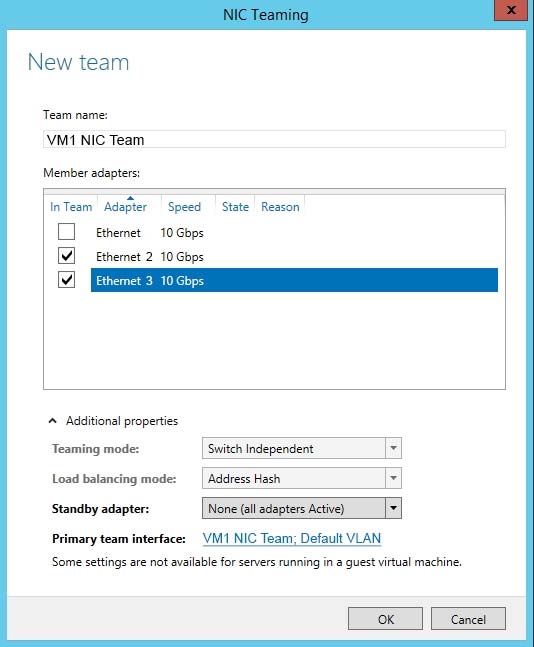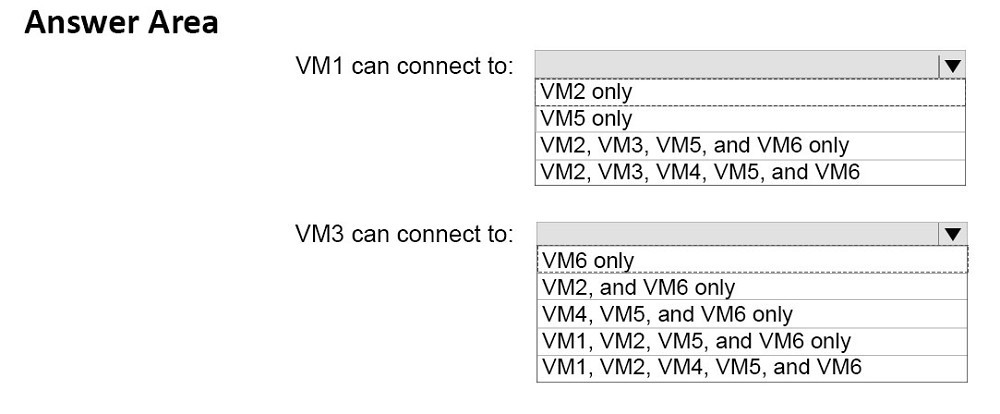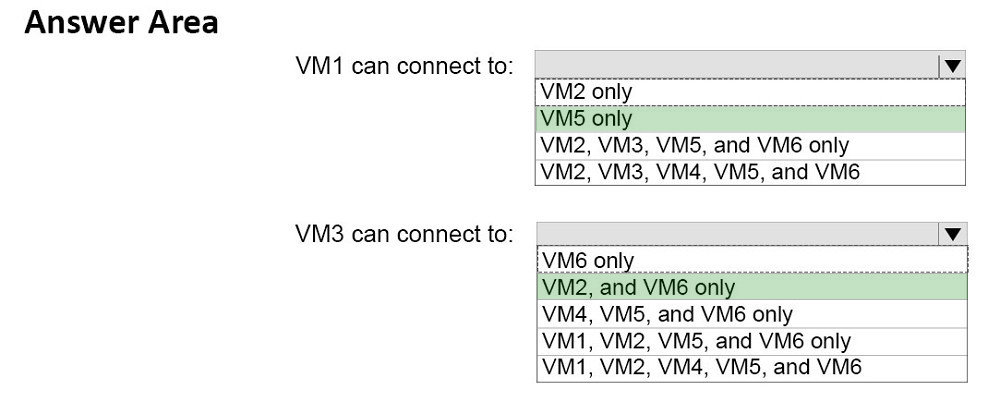Microsoft 70-743 Exam Practice Questions (P. 3)
- Full Access (231 questions)
- Six months of Premium Access
- Access to one million comments
- Seamless ChatGPT Integration
- Ability to download PDF files
- Anki Flashcard files for revision
- No Captcha & No AdSense
- Advanced Exam Configuration
Question #11
You have a virtual machine named VM1 that runs Windows Server 2016. VM1 hosts a service that requires high network throughput.
VM1 has a virtual network adapter that connects to a Hyper-V switch named vSwitch1. vSwitch1 has one network adapter. The network adapter supports Remote
Direct Memory Access (RMDA), the Single Root I/O Virtualization (SR-IOV) interface, Quality of Service (QoS), and Receive Side Scaling (RSS).
You need to ensure that the traffic from VM1 can be processed by multiple networking processors.
Which Windows PowerShell command should you run on the host of VM1?
VM1 has a virtual network adapter that connects to a Hyper-V switch named vSwitch1. vSwitch1 has one network adapter. The network adapter supports Remote
Direct Memory Access (RMDA), the Single Root I/O Virtualization (SR-IOV) interface, Quality of Service (QoS), and Receive Side Scaling (RSS).
You need to ensure that the traffic from VM1 can be processed by multiple networking processors.
Which Windows PowerShell command should you run on the host of VM1?
- ASet-NetAdapterRss
- BSet-NetAdapterRdma
- CSet-NetAdapterSriov
- DSet-NetAdapterQoS
Correct Answer:
A
The Set-NetAdapterRss cmdlet sets the receive side scaling (RSS) properties on a network adapter. RSS is a scalability technology that distributes the receive network traffic among multiple processors by hashing the header of the incoming packet. Without RSS Windows Server 2012/2016; network traffic is received on the first processor which can quickly reach full utilization limiting receive network throughput. Many properties can be configured using the parameters to optimize the performance of RSS. The selection of the processors to use for RSS is an important aspect of load balancing. Most of the parameters for this cmdlet help to determine the processors used by RSS.
A
The Set-NetAdapterRss cmdlet sets the receive side scaling (RSS) properties on a network adapter. RSS is a scalability technology that distributes the receive network traffic among multiple processors by hashing the header of the incoming packet. Without RSS Windows Server 2012/2016; network traffic is received on the first processor which can quickly reach full utilization limiting receive network throughput. Many properties can be configured using the parameters to optimize the performance of RSS. The selection of the processors to use for RSS is an important aspect of load balancing. Most of the parameters for this cmdlet help to determine the processors used by RSS.
send
light_mode
delete
Question #12
You have a server named Server1 that runs Windows Server 2016. Server1 is a Hyper-V host that hosts a virtual machine named VM1.
Server1 has three network adapter cards that are connected to virtual switches named vSwitch1, vSwitch2 and vSwitch3.
You configure NIC Teaming on VM1 as shown in the exhibit. (Click the Exhibit button.)

You need to ensure that VM1 will retain access to the network if a physical network adapter card fails on Server1.
What should you do?
Server1 has three network adapter cards that are connected to virtual switches named vSwitch1, vSwitch2 and vSwitch3.
You configure NIC Teaming on VM1 as shown in the exhibit. (Click the Exhibit button.)

You need to ensure that VM1 will retain access to the network if a physical network adapter card fails on Server1.
What should you do?
- AFrom Hyper-V Manager on Server1, modify the settings of VM1.
- BFrom Windows PowerShell on VM1, run the Set-VmNetworkAdapterTeamMapping cmdlet.
- CFrom Windows PowerShell on Server1, run the Set-VmNetworkAdapterFailoverConfiguration cmdlet.
- DFrom Hyper-V Manager on Server1, modify the properties of vSwitch1.
Correct Answer:
A
You can configure NIC teaming in the Guest OS; however, before NIC teaming will work in a virtual machine, you need to enable NIC teaming in the Advanced
Features section of the VM settings.
A
You can configure NIC teaming in the Guest OS; however, before NIC teaming will work in a virtual machine, you need to enable NIC teaming in the Advanced
Features section of the VM settings.
send
light_mode
delete
Question #13
HOTSPOT -
You have an Active Directory domain named Contoso.com. The domain contains Hyper-V hosts named Server1 and Server2 that run Windows Server 2016. The
Hyper-V hosts are configured to use NVGRE for network virtualization.
You have six virtual machines that are connected to an external switch. The virtual machines are configured as shown.

To which virtual machine or virtual machines can VM1 and VM3 connect? To answer, select the appropriate options in the answer area.
Hot Area:

You have an Active Directory domain named Contoso.com. The domain contains Hyper-V hosts named Server1 and Server2 that run Windows Server 2016. The
Hyper-V hosts are configured to use NVGRE for network virtualization.
You have six virtual machines that are connected to an external switch. The virtual machines are configured as shown.

To which virtual machine or virtual machines can VM1 and VM3 connect? To answer, select the appropriate options in the answer area.
Hot Area:

Correct Answer:

The GRE keys must match.
To separate the traffic between the two virtualized networks, the GRE headers on the tunneled packets include a GRE Key that provides a unique Virtual Subnet
ID for each virtualized network.
References:
https://blogs.technet.microsoft.com/keithmayer/2012/10/08/step-by-step-hyper-v-network-virtualization-31-days-of-favorite-features-in-winserv-2012-part-8-of-31/

The GRE keys must match.
To separate the traffic between the two virtualized networks, the GRE headers on the tunneled packets include a GRE Key that provides a unique Virtual Subnet
ID for each virtualized network.
References:
https://blogs.technet.microsoft.com/keithmayer/2012/10/08/step-by-step-hyper-v-network-virtualization-31-days-of-favorite-features-in-winserv-2012-part-8-of-31/
send
light_mode
delete
Question #14
You have a Nano Server named Nano1.
You deploy several containers to Nano1 that use an image named Image1.
You need to deploy a new container to Nano1 that uses Image1.
What should you run?
You deploy several containers to Nano1 that use an image named Image1.
You need to deploy a new container to Nano1 that uses Image1.
What should you run?
- Athe Install-WindowsFeature cmdlet
- Bthe docker run command
- Cthe docker load command
- Dthe Install-NanoServerPackage cmdlet
Correct Answer:
B
When an operator executes docker run, the container process that runs is isolated in that it has its own file system, its own networking, and its own isolated process tree separate from the host.
The basic docker run command takes this form:
$ docker run [OPTIONS] IMAGE[:TAG|@DIGEST] [COMMAND] [ARG...]
B
When an operator executes docker run, the container process that runs is isolated in that it has its own file system, its own networking, and its own isolated process tree separate from the host.
The basic docker run command takes this form:
$ docker run [OPTIONS] IMAGE[:TAG|@DIGEST] [COMMAND] [ARG...]
send
light_mode
delete
Question #15
You have a server named Server1 that runs Windows Server 2016.
You plan to deploy Internet Information Services (IIS) in a Windows container.
You need to prepare Server1 for the planned deployment.
Which three actions should you perform? Each correct answer presents part of the solution.
You plan to deploy Internet Information Services (IIS) in a Windows container.
You need to prepare Server1 for the planned deployment.
Which three actions should you perform? Each correct answer presents part of the solution.
- AInstall the Container feature.
- BInstall Docker.
- CInstall the Base Container Images.
- DInstall the Web Server role.
- EInstall the Hyper-V server role.
Correct Answer:
ABC
Step 1 (A): The container feature needs to be enabled before working with Windows containers. To do so run the following command in an elevated PowerShell session.
Enable-WindowsOptionalFeature -Online -FeatureName containers All
Step 2 (B): Docker is required in order to work with Windows containers.
Note: First install the OneGet PowerShell module.
Install-Module -Name DockerMsftProvider -Repository PSGallery -Force
Next you use OneGet to install the latest version of Docker.
Install-Package -Name docker -ProviderName DockerMsftProvider
Step 3 (C): Install Base Container Images
Windows containers are deployed from templates or images. Before a container can be deployed, a container base OS image needs to be downloaded. The following commands will download the Nano Server base image.
Pull the Nano Server base image.
docker pull microsoft/nanoserver
ABC
Step 1 (A): The container feature needs to be enabled before working with Windows containers. To do so run the following command in an elevated PowerShell session.
Enable-WindowsOptionalFeature -Online -FeatureName containers All
Step 2 (B): Docker is required in order to work with Windows containers.
Note: First install the OneGet PowerShell module.
Install-Module -Name DockerMsftProvider -Repository PSGallery -Force
Next you use OneGet to install the latest version of Docker.
Install-Package -Name docker -ProviderName DockerMsftProvider
Step 3 (C): Install Base Container Images
Windows containers are deployed from templates or images. Before a container can be deployed, a container base OS image needs to be downloaded. The following commands will download the Nano Server base image.
Pull the Nano Server base image.
docker pull microsoft/nanoserver
send
light_mode
delete
All Pages
